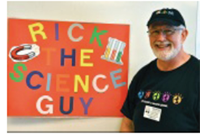Go Deep!
 STEM teaching in high schools: There’s so much to cover. And so little time to prepare an excellent lesson. According to the OECD, U.S. high school teachers are employed to work almost 2,000 hours per year. For every hour of in-class instruction, there is only about one other hour to do everything else: grade papers, figure out homework assignments, prepare next lessons and do PD – Professional Development. Good luck with that! Adding to the stress is that “The System” always seems to be changing. These days we can point to implementation of Common Core State Standards and Next Generation Science Standards (NGSS). Beyond frequent changes like these, we have on-going debates about “teaching to a test” with such high value placed – by parents and colleges – on students’ numerical scores on multiple-choice tests. A teacher’s job security may be at risk if the students in her/his class do not score high enough. No wonder there is such teacher turnover/dropout, especially in the early years. Read more. STEM teaching in high schools: There’s so much to cover. And so little time to prepare an excellent lesson. According to the OECD, U.S. high school teachers are employed to work almost 2,000 hours per year. For every hour of in-class instruction, there is only about one other hour to do everything else: grade papers, figure out homework assignments, prepare next lessons and do PD – Professional Development. Good luck with that! Adding to the stress is that “The System” always seems to be changing. These days we can point to implementation of Common Core State Standards and Next Generation Science Standards (NGSS). Beyond frequent changes like these, we have on-going debates about “teaching to a test” with such high value placed – by parents and colleges – on students’ numerical scores on multiple-choice tests. A teacher’s job security may be at risk if the students in her/his class do not score high enough. No wonder there is such teacher turnover/dropout, especially in the early years. Read more.
PISA 2012: Results as expected
 A few weeks ago, the results of the 2012 PISA (Programme for International Student Assessment) test were released, causing quite a stir across the country. You can read the full results here, but in short, the United States performance has actually declined in Math and Reading, and only improved slightly in Science, since the test was first administered in 2003. More troubling is that other nations have shown an upward trend, with 16-22 countries now performing statistically significant above the US score, depending on the subject. A few weeks ago, the results of the 2012 PISA (Programme for International Student Assessment) test were released, causing quite a stir across the country. You can read the full results here, but in short, the United States performance has actually declined in Math and Reading, and only improved slightly in Science, since the test was first administered in 2003. More troubling is that other nations have shown an upward trend, with 16-22 countries now performing statistically significant above the US score, depending on the subject.
Of course, both sides of the debate around education reform were very vocal in interpreting these results. Opponents of standards-based reform believe that these results show that the reforms of the last decade have and little or no impact, and that it is time for us to get rid of standardized tests all together. Read more. |
 |
STEM Initiatives at IBM
 I retire from IBM at the end of the year after almost an LP’s worth of time - 33⅓ years☺. I thought it appropriate to use this final column as the IBM STEM Advocate to summarize just a few of the many IBM programs that support STEM and more. I retire from IBM at the end of the year after almost an LP’s worth of time - 33⅓ years☺. I thought it appropriate to use this final column as the IBM STEM Advocate to summarize just a few of the many IBM programs that support STEM and more.
I’ll start with Pathways in Technology Early College High School, P-TECH for short. That program launched over two years ago as a partnership among The City University of New York, New York City College of Technology, the New York City Department of Education, and IBM – an academic / government / industry partnership model. P-TECH was a new approach to grades 9-14 education; students graduate with an associates degree in applied science; each student has a mentor throughout their time at P-TECH; and most have an intern experience as well. Read more.
An IBM Tribute to the Retiring "Dr. Kold”
 “Arguably, if you look around a room, there is little that hasn’t been influenced or doesn't owe its existence to science, technology, engineering and math—the ‘STEM’ disciplines as we call them,” says Rick McMaster, a project manager for IBM in the United States and the company’s STEM advocate in university programs—a career that matches his passion for engaging students. “Arguably, if you look around a room, there is little that hasn’t been influenced or doesn't owe its existence to science, technology, engineering and math—the ‘STEM’ disciplines as we call them,” says Rick McMaster, a project manager for IBM in the United States and the company’s STEM advocate in university programs—a career that matches his passion for engaging students.
The acronym for Science Technology Engineering Math (STEM) is often associated with the effort to bolster school curriculums and student participation in those subjects. Some countries have difficulty both attracting a diverse student population in STEM, which is important for fresh perspectives, and retaining those who started studies in STEM but have become discouraged. Download PDF to read more. |